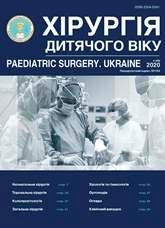A comparative study to evaluate the morphological features in undescended testes and changes following orchiopexy
DOI:
https://doi.org/10.15574/PS.2020.69.63Keywords:
Undescended testis, testicular volume, peak systolic velocity, end diastolic velocity, perioperativeAbstract
A successful operative treatment of undescended testis has always been defined as a comparable scrotal position of the testis with no evidence of atrophic changes. The most important determinants for this are the type of undescended testis i.e. palpable and non-palpable and the timing of surgery. The ultimate goal of orchiopexy is to preserve its spermatogenic potential. However, that can only be ascertained at a later age. Therefore, early assessment of the procedure has been suggested by some radiological features. We undertook this study to evaluate these blood flow parameters.
References
Ashley RA, Barthold JS, Kolon TF. (2010). Cryptorchidism: pathogenesis, diagnosis, treatment and prognosis. Urologic Clinics. 37(2): 183-93. https://doi.org/10.1016/j.ucl.2010.03.002; PMid:20569797
Atilla MK, Sargin H, Yilmaz Y, Odabas O, Keskin A, Aydin S. (1997). Undescended testes in adults: clinical significance of resistive index values of the testicular artery measured by Doppler ultrasound as a predictor of testicular histology. J Urol. 158: 841-3. https://doi.org/10.1016/S0022-5347(01)64332-5
Bahk JY, Jung JH, Jin LM, Min SK. (2010). Cut-off value of testes volume in young adults and correlation among testes volume, body mass index, hormonal level, and seminal profiles. Urology. 75: 1318-23. https://doi.org/10.1016/j.urology.2009.12.007; PMid:20299083
Berkowitz GS, Lapinski RH, Gazella JG, Dolgin SE, Bodian CA, Holzman IR. (1993). Prevalence and natural history of cryptorchidism. Pediatrics. 92(1): 44-9.
Biagiotti G, Cavallini G, Modenini F, Vitali G, Gianaroli L. (2002). Spermatogenesis and spectral echo-colour Doppler traces from the main testicular artery. BJU Int. 90:903-8. https://doi.org/10.1046/j.1464-410X.2002.03033.x; PMid:12460354
Chung E, Brock GB. (2011). Cryptorchidism and its impact on male fertility: a state of art review of current literature. Canadian Urological Association Journal. 5(3): 210-4. https://doi.org/10.5489/cuaj.1010; PMid:21672488 PMCid:PMC3114036
Hsu TH, Huang JK, Ho DM, Liu RS, Chen MT, Chang LS. (1993). Role of the spermatic artery in spermatogenesis and sex hormone synthesis. ArchAndrol. 31: 191-7. https://doi.org/10.3109/01485019308988399; PMid:8274045
Gill B, Kogan S. (1997). Cryptorchidism: current concepts. Pediatric Clinics of North America. 44(5): 1211-27. https://doi.org/10.1016/S0031-3955(05)70554-X
Jee WH, Choe BY, Byun JY, Shinn KS, Hwang TK. (1997). Resistive index of the intrascrotal artery in scrotal inflammatory disease. Acta Radiol. 38: 1026-30. https://doi.org/10.1080/02841859709172124; PMid:9394663
Jezek D, Schulze W, Rogatsch H, Hittmair A. (1996). Structure of small blood vessels in the testes of infertile men. Int J Androl. 19: 299-306. https://doi.org/10.1111/j.1365-2605.1996.tb00479.x; PMid:8985779
Kim SO, Hwang EC, Hwang IS, Oh KJ, Jung SI, Kang TW, Kwon D, Park K, Bang-Ryu S. (2011). Testicular catch up growth: the impact of orchiopexy age. Urology. 78(4): 886-90. https://doi.org/10.1016/j.urology.2011.04.057; PMid:21762966
Kolon TF, Herndon CD, Baker LA, Baskin LS, Baxter CG, Cheng EY, Diaz M, Lee PA, Seashore CJ, Tasian GE, Barthold JS. (2014). Evaluation and treatment of cryptorchidism: American Urological Association (AUA) Guideline. J Urol. 192(2): 337-45. https://doi.org/10.1016/j.juro.2014.05.005; PMid:24857650
Kurpisz M, Havryluk A, Nakonechnyj A, Chopyak V, Kamieniczna M. (2010). Cryptorchidism and long-term consequences. Reproductive biology. 10(1): 19-35. https://doi.org/10.1016/S1642-431X(12)60035-7
Mathers MJ, Sperling H, Rubben H, Roth S. (2009). The undescended testis: diagnosis, treatment and long-term consequences. Deutsches Arzteblatt International. 106(33): 527. https://doi.org/10.3238/arztebl.2009.0527; PMid:19738919 PMCid:PMC2737432
Murphy F, Paran TS, Puri P. (2007). Orchidopexy and its impact on fertility. Pediatric surgery international. 23(7): 625-32. https://doi.org/10.1007/s00383-007-1900-3; PMid:17431642
Pinggera GM, Mitterberger M, Bartsch G, Strasser H, Gradl J, Aigner F, Pallwein L, Frauscher F. (2008). Assessment of the intratesticular resistive index by colour Doppler ultrasonography measurements as a predictor of spermatogenesis. BJU Int. 101: 722-6. https://doi.org/10.1111/j.1464-410X.2007.07343.x; PMid:18190642
Zvizdic Z, Milisic E, Halimic A, Zvizdic D, Zubovic SV. (2014). Testicular volume and testicular atrophy index as predictors of functionality of unilaterally cryptorchid testis. Medical Archives. 68(2): 79. https://doi.org/10.5455/medarh.2014.68.79-82; PMid:24937926 PMCid:PMC4272499
Downloads
Published
Issue
Section
License
The policy of the Journal “PAEDIATRIC SURGERY. UKRAINE” is compatible with the vast majority of funders' of open access and self-archiving policies. The journal provides immediate open access route being convinced that everyone – not only scientists - can benefit from research results, and publishes articles exclusively under open access distribution, with a Creative Commons Attribution-Noncommercial 4.0 international license(СС BY-NC).
Authors transfer the copyright to the Journal “PAEDIATRIC SURGERY.UKRAINE” when the manuscript is accepted for publication. Authors declare that this manuscript has not been published nor is under simultaneous consideration for publication elsewhere. After publication, the articles become freely available on-line to the public.
Readers have the right to use, distribute, and reproduce articles in any medium, provided the articles and the journal are properly cited.
The use of published materials for commercial purposes is strongly prohibited.

